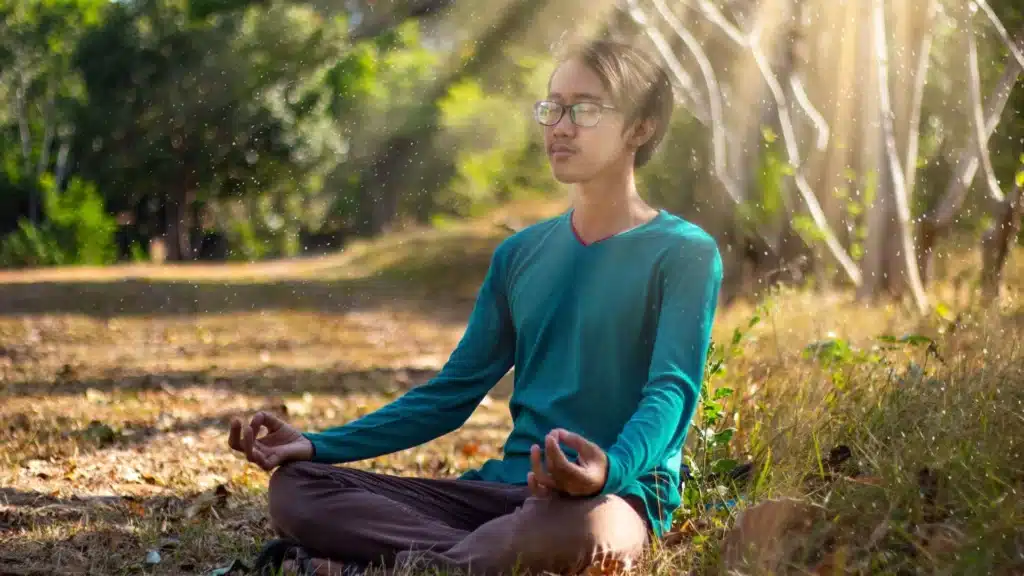Teenagers can find a flurry of emotions, social pressure, and academic difficulty during their years. It can feel daunting with homework mounting, relationships changing, and personal development under full tilt. Mindfulness exercises for teens can assist them in controlling their thoughts, alleviating worry, and remaining grounded in the present moment, especially during stressful times.
Mindfulness is a skill that teaches mindfulness for beginners, allowing teens to observe the present moment without judgment. It exhorts teenagers to participate completely in whatever they are doing—eating, walking, even just breathing. Although meditation is usually connected with awareness, it does not always mean sitting quietly and cleansing the mind. Actually, mindfulness is a useful and efficient strategy for teenagers to deal with the demands of daily life since it can be included into regular activities.
In this post, we will explore mindfulness exercises for teens that can support mental health, focus, and emotional well-being..
Why Mindfulness is Important for Teens
Mindfulness is especially important for stress management and mental health improvement, fostering resilience and inner peace in teenagers. Here’s how teens might gain from mindfulness practice:
- Reduces Stress and Anxiety: Breathing techniques for students can help alleviate stress and anxiety caused by academic demands, peer interactions, and family issues. By helping teenagers slow down and calm their thoughts, mindfulness activities reduce stress and anxiety.
- Improves Focus and Concentration: Mindfulness practice encourages daily peace rituals that enhance a teenager’s ability to focus and concentrate in class or on other activities.
- Enhances Emotional Regulation: Mindfulness plays a crucial role in teaching inner peace for teenagers, allowing them to become more aware of their emotions and respond calmly to challenges.
- Boosts Self-Awareness and Empathy: Mindfulness helps teenagers to grow more self-aware, therefore enhancing their self-esteem and capacity for empathy with others.
- Promotes Healthy Coping Mechanisms: Through mindfulness, teenagers learn meditation for teens, which helps them better manage challenging emotions and reduce reliance on negative coping mechanisms.
Top 20 Simple Mindfulness Exercises for Teens
Mindfulness exercises for teens are incredibly helpful for stress management, boosting concentration, and promoting emotional well-being. Teens who include mindfulness techniques into their regular routines can lower anxiety, increase mental clarity, and raise their emotional intelligence. We will go over twenty basic mindfulness activities meant especially for teenagers in this post.
Whether at home, in a classroom, or even at a social event, these simple to follow activities can be done at any moment. Let’s explore these useful mindfulness exercises meant to assist teenagers increase mental health, control emotions, and improve self-awareness.
1. Mindful Breathing
Among the most basic and powerful mindfulness practices is conscious breathing. Teenagers who concentrate on breathing will rapidly quiet their body and thoughts.
How to Practice:
- Relax and close your eyes.
- Deeply inhale through your nose; hold for a second then gently exhale through your mouth.
- Focus on how your breath feels entering and leaving your body, grounding yourself and finding inner peace for teenagers.
- Should your attention go, softly bring it back to your breath.
2. Body Scan Meditation
The body scan technique helps teens relax and practice mindfulness for beginners, checking in with their body and releasing tension.
How to Practice:
- Lay down and close your eyes.
- Beginning with your toes, progressively focus on every muscle group in your body.
- As you inhale deeply, concentrate on any sensations or tensions in every place and let them calm themselves.
3. Grounding with 5-4-3-2-1
Engaging all five senses, this grounding practice helps teenagers link with the present.
How to Practice:
- 5 Things You Can See: Notice five things around you.
- 4 Things You Can Touch: Feel four objects or textures near you.
- 3 Things You Can Hear: Listen to three sounds.
- 2 Things You Can Smell: Identify two scents.
- 1 Thing You Can Taste: Focus on one taste.
4. Mindful Eating
Teenagers who practise mindful eating pay close attention to textures, tastes, and odours, therefore enabling them to really interact with their meal.
How to Practice:
- Get hold of a slice of food, say an apple.
- Before you eat, consider texture, colour, and scent.
- Chew gently and notice with every bite the taste and sensations.
5. Deep Breathing
Practicing breathing techniques for students can help release mental tension, promoting relaxation and calmness.
How to Practice:
- Inhale gently for four counts; hold for four, then exhale for four.
- Concentrating on the rhythm of your breath, repeat for several minutes.
6. Progressive Muscle Relaxation
Focussing on several muscle areas in the body, this method helps teenagers relieve stress.
How to Practice:
- Start with your feet and spend a few seconds tensing the muscles.
- Release slowly; observe the relaxation.
- Tightening and relaxing muscles, move through every muscle group from feet to head.
7. Mindful Walking
By practicing classroom mindfulness, teens can stay connected with their body and surroundings, combining mindfulness and movement even in a busy classroom.
How to Practice:
- Go slowly, focussing on the feeling of your feet on the earth.
- Pay close attention to the sights, smells, and sounds in your surroundings.
- Keep present with every step, observing how your body feels as you move.
8. Visualization Meditation
Visualization meditation offers a way for teens to practice meditation for teens, helping them relax by imagining peaceful environments.
How to Practice:
- Close your eyes, inhale deeply a few times.
- Imagine a serene environment, maybe a forest or beach.
- Emphasise the views, noises, and emotions of being in that location.
9. Journaling
Journaling is one of the daily habits for teen mental clarity, helping teenagers clear their mind and process their emotions.
How to Practice:
- Plan time to write freely about your ideas, emotions, and experiences.
- Emphasise the here-now and write without self-editing or judgement.
- Ask “What am I grateful for today?” for cues. Alternatively “How do I feel right now?”
10. Listening to Music Mindfully
Mindful music listening helps to improve emotional awareness.
How to Practice:
- Pick a song and really listen to it.
- Pay especially attention to the melody, lyrics, instruments, and rhythm.
- See how the music emotionally speaks to you.
11. Mindful Coloring
One creative and leisureful mindfulness exercise is colouring.
How to Practice:
- Print a colouring page or pick up a colouring book.
- Pay particular attention to the colours and colouring techniques.
- As you work creatively, let other ideas fade away.
12. Gratitude Journaling
Encouragement of what one is grateful for will assist teenagers change their perspective to one of optimism.
How to Practice:
- Jot down three daily blessings for each other.
- Think about why these things cause you to be thankful.
13. Mindful Listening
Emphasising the act of listening, this practice improves mindfulness and communication.
How to Practice:
- Select someone you could listen to and offer your whole attention.
- Pay especially attention to their body language, voice tone, and words.
- Steer clear of interrupting and pay open mind attention.
14. Mantra Meditation
Teenagers who repeat a soothing word or phrase will be better able to concentrate and less stressed.
How to Practice:
- Choose one of “peace,” “calm,” or “I am enough.”
- Quietly repeat the chant with every inhale.
- Give the words’ sound and meaning top priority.
15. Mindful Observation
Teenagers can learn to be present by seeing their surroundings with this exercise.
How to Practice:
- Engage in mindful observation by taking a moment to observe your surroundings with full attention, noticing things you may have missed before.
- Choose one scene or object to closely study.
- See the colours, forms, textures, and other elements you might not have seen previously.
16. The Raisin Exercise
Teens learning the sultana exercise learn to slow down and interact with their meal.
How to Practice:
- Hold a sultana or tiny morsel of food.
- See it closely using all your senses; look at it, feel it, scent it, and lastly eat it gently.
17. Breathing with a Pinwheel
For teenagers who appreciate visual signals especially, this is an interesting activity to practise controlled breathing.
How to Practice:
- Present a pinwheel before you.
- To cause the pinwheel to spin, inhale deeply and gently blow it out.
- Work on your breathing and the spinning action.
18. Emotion Wheel
Teenagers can better recognise and communicate their emotions by means of the emotional wheel.
How to Practice:
- Make your own printable emotional wheel or use one already available.
- Point to the feeling you now have and consider it.
- Breathe deeply a few times then observe how your emotions evolve as you concentrate on them.
19. Bubble Breathing
Teenagers can learn deep breathing in a fun approach with bubble breathing.
How to Practice:
- Imagine yourself blowing bubbles.
- Breathe slowly deeply in, then gently exhale as though blowing bubbles.
- Emphasise the sound of the exhale and the seamless breathing flow.
20. Mindful Stretching
Teenagers who practise mindful stretching find physical stress released and remain grounded.
How to Practice:
- Stressing the sensation in every muscle group, do a sequence of light stretches.
- As you stretch, inhale deeply and experience how your body responds.
Making Mindfulness a Habit
Mindfulness must become a daily habit if it is to be really beneficial. Here are some suggestions on how teenagers could regularly practise mindfulness:
- Start small: Starting with brief mindfulness activities lasting only a few minutes every day helps ease things.
- Make it fun: Add mindfulness to activities teenagers like, such painting or listening to music.
- Set reminders: Perhaps after school or before bed, to practise mindfulness at the same time each day.
- Be patient: Mindfulness might not feel natural right away. As they practise, inspire teenagers to be patient and non judgemental towards themselves.
Conclusion
For teenagers trying to control stress, increase focus, and boost emotional well-being, mindfulness is a great tool. Teenagers can develop calm, raise self-awareness, and strengthen their mental health by including these twenty easy mindfulness activities into their daily schedules. Whether through journaling, mindful walking, or conscious breathing, mindfulness exercises for teens help them stay grounded and present in the moment. Start small, be patient, and progressively schedule regular mindfulness practice for long-term benefits. moment. Start small, be patient, and gradually make mindfulness a regular practice for lasting benefits.







